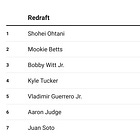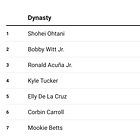Fantasy Baseball 2025 Redraft Top 500 Rankings & Trade Value Version 2.17
This week: One of fantasy’s best save stashes, and two starting pitchers who are turning things around at the right time.
In this week’s Top 500 update, a pitcher you’ll want to have on your roster if you’re looking for high-upside save stashes.
Plus, two starting pitchers missing bats at decidedly above-average rates who are worth a look as trade targets.
(A quick note, if you’re having trouble reading the table in full in the Substack app, it can be viewed in full either in the email or in a web browser.)
If you have any questions about trade offers, the waiver wire, last minute start/sit options, roster construction strategies, or anything specific to your fantasy team, becoming a paid subscriber grants you access to my daily fantasy help chat where I’ll be answering all of your fantasy baseball questions every weekday, whether it’s redraft or dynasty, or during the offseason, draft season, the regular season or the fantasy playoffs. The main goal of this Substack? To help you win your fantasy leagues.
Ryan Zeferjahn (#325, 22 trade value).
With the news that Ben Joyce will miss the rest of the season due to shoulder surgery, Ryan Zeferjahn immediately becomes one of the most intriguing fantasy stashes for those looking to add saves ahead of time.
His stat line isn’t perfect. He’s walking batters at a 10.8% rate and has allowed opposing hitters to manage a 55.0% hard-hit rate against him.
But, his ability to miss bats at an elite rate would vault him into the top 10 among fantasy closers if he ever stepped into a ninth-inning role for an extended amount of time.
The Angels have been on a tear lately, winning seven in a row, but they’re still under .500 and sporting a 3.1% playoff odds as of Wednesday per FanGraphs. Crazier things have happened, and it’s still incredibly early in the season where playoff odds are concerned, but if they do end up having to trade veterans at the deadline and trade away Kenley Jansen, Zeferjahn is going to be one of the most popular names available via waivers.
If you have a deep bench, it’s not the worst time to add him to your roster now.
Either the Halos trade veterans in July and he becomes a closer, or, he’s a quality saves stash who could step in and make an impact in the event Jansen were to miss time due to injury.
Will Warren (#135, 58 trade value).
Just in the same way that you should take a batter’s batting average with a notable grain of salt, the same can probably be true of a starting pitcher’s ERA, particularly Will Warren’s.
The 25-year-old has pitched to a 4.05 ERA in 46.2 innings (spanning 10 starts) while adding 11.57 strikeouts per nine innings and allowing 3.47 walks and 0.77 homers per nine frames.
If you’re starting to do the math at home, you can probably guess where this is going. With all those strikeouts, Warren might have a strong FIP.
And, you’d be right. He does.
It’s 2.84 to be exact.
Overall, Warren sits in the 87th percentile league-wide in strikeout rate (29.7%) and in the 69th percentile league-wide in whiff rate (27.8%).
There are still some unideal stats. Opposing batters have a 50.0% hard-hit rate against him. And, despite having one of the 31 lowest HR/9 rates among pitchers with at least 40 innings pitched this season, Warren is in the 22nd percentile league-wide in barrel rate with a 10.7% number accumulated by batters against him.
So there might be some regression coming in the home run department. Still, so much swing and miss upside, combined with the pitcher win upside provided by playing for the New York Yankees, puts Warren’s fantasy ceiling in impact territory.
Now might be the last time his perceived fantasy trade value is this low.
Gavin Williams (#169, 49 trade value).
Sticking with starting pitchers missing plenty of bats, Williams’ run-prevention numbers are still a bit high on the season, with a 3.94 ERA and a 4.22 FIP in 48 innings, but he looks to be turning things around after a slow start.
In six starts through April 28, Williams struggled with walks and home runs. Sure, he struck out 28 batters in 28 innings and logged a decidedly above-average 13.3% swinging strike rate, but 4.50 walks and 1.61 homers per nine frames certainly weren’t ideal for his production. Furthermore, he failed to reach four innings in two of those six starts.
Since then, Wiliams actually has more strikeouts (29) in eight fewer innings (20) during that span, pitching to a 2.25 ERA and a 3.28 FIP.
And while his walks per nine innings rate during the stretch (5.40) is still reasonably high, the high strikeout totals and sudden decrease in home runs allowed (Williams gave up just 0.90 per nine frames since April 29) make the walks much easier to live with.
Furthermore, despite the elevated walk rate, Williams still had a FIP below the 3.30 mark during that stretch. If he can even shave 1.00 or 2.00 off his walks per nine innings rate, he could vault into the top 100 of these rankings.
Beware the Open Roster Spot (Or lack thereof)
Oh and one more quick note, beware the open roster spot, or lack thereof rather, in trades.
While a two-for-one or even a three-for-one or four-for-two deal might line up from a trade value standpoint, the roster spots are worth considering. Essentially, if you’re having to cut someone, it turns into you giving up another player or players in addition to potentially the best player in the deal. It’s obviously a different story if you’re working with a flexible roster or open roster spots, but it adds another layer to deals that can potentially change the calculus of things considerably.
Recent Rankings:
New Weekly Column Alert! (Check out Week 1’s column for free!)
League Winners Week 1: Three Potential (Future) Aces
Welcome to League Winners! A new weekly, in-season column that I’m really excited to debut.
Also:
Using Whiff Rate To Find Bounce-Back (And Breakout) Fantasy SP Candidates
Let’s get this out of the way first.






